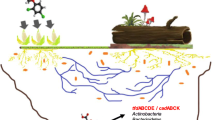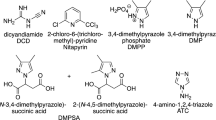Abstract
l-meta-tyrosine is an herbicidal nonprotein amino acid isolated some years ago from fine fescue grasses and characterized by its almost immediate microbial degradation in soil (half-life <24 h). Nine monohalogenated or dihalogenated analogs of this allelochemical have been obtained through a seven-step stereoselective synthesis from commercial halogenated phenols. Bioassays showed a large range of biological responses, from a growth root inhibition of lettuce seedling similar to that noted with m-tyrosine [2-amino-3-(2-chloro-5-hydroxyphenyl)propanoic acid or compound 8b] to an increase of the primary root growth concomitant with a delay of secondary root initiation [2-amino-3-[2-fluoro-5-hydroxy-3-(trifluoromethyl)phenyl]propanoic acid or compound 8h]. Compound 8b was slightly less degraded than m-tyrosine in the nonsterilized nutritive solution used for lettuce development, while the concentration of compound 8h remained unchanged for at least 2 weeks. These data indicate that it is possible to manipulate both biological properties and degradation of m-tyrosine by halogen addition.





Similar content being viewed by others
References
Bais HP, Weir TL, Perry LG, Gilroy S, Vivanco JM (2006) The role of root exudates in rhizosphere interations with plants and other organisms. Annu Rev Plant Biol 57:233–266
Bertin C, Weston LA (2002) Fescue ecology, physiology, and allelopathy—a case study. In: Reigosa MJ, Pedrol N (eds) Allelopathy: from molecules to ecosystems. Science Publisher, Inc., New Hampshire, pp 93–112
Bertin C, Weston LA, Huang T, Jander G, Owens T, Meinwald J, Schroeder FC (2007) Grass roots chemistry: meta-tyrosine, an herbicidal nonprotein amino acid. Proc Natl Acad Sci USA 104:16964–16969
Bertin C, Harmon R, Akaogi M, Weidenhamer JD, Weston LA (2009) Assessment of the phytotoxic potential of m-tyrosine in laboratory soil bioassays. J Chem Ecol 35:1288–1294
Birkett MA, Chamberlain K, Hooper AM, Pickett JA (2001) Does allelopathy offer real promise for practical weed management and for explaining rhizosphere interactions involving higher plants? Plant Soil 232:31–39
Bovonsombat P, Khanthapura P, Krause MM, Leykajarakul J (2008) Facile syntheses of 3-halo and mixed 3,5-dihalo analogues of N-acetyl-l-tyrosine via sulfonic acid-catalysed regioselective monohalogenation. Tetrahedron Lett 49:7008–7011
Caro JH (1969) Accumulation by plants of organochlorine insecticides from soil. Phytopathology 59:1191–1197
Chen L, Ortiz-Lopez A, Jung A, Bush DR (2001) ANT1, an aromatic and neutral amino acid transporter in Arabidopsis. Plant Physiol 125:1813–1820
Chollet JF, Deletage C, Faucher M, Miginiac L, Bonnemain JL (1997) Synthesis and structure–activity relationships of some pesticides with an alpha-amino acid function. Biochim Biophys Acta 1336:331–341
Chou CH (2006) Introduction to allelopathy. In: Reigosa MJ, Pedrol N, González L (eds) Allelopathy: a physiological process with ecological implications. Springer, Dordrecht, pp 1–9
Clark RD (2012) A perspective on the role of quantitative structure–activity and structure–property relationships in herbicide discovery. Pest Manage Sci 68:513–518
Dayan FE, Owens DK, Duke SO (2012) Rationale for a natural products approach to herbicide discovery. Pest Manage Sci 68:519–528
Deletage-Grandon C, Chollet JF, Faucher M, Rocher F, Komor E, Bonnemain JL (2001) Carrier-mediated uptake and phloem systemy of a 350-Dalton chlorinated xenobiotic with an alpha-amino acid function. Plant Physiol 125:1620–1632
Drain DJ, Howes JGB (1967) Phenylalanine derivatives and their preparation. United Kingdom Patent GB1068937
Duke SO, Lydon J (1993) Natural phytotoxins as herbicides. In: Duke SO, Menn JJ, Plimmer JR (eds) Pest control with enhanced environmental safety. ACS symposium series, vol. 524. American Chemical Society, Washington, pp 110–124
Duke SO, Abbas HK (1995) Natural products with potential use as herbicides. In: Inderjit A, Dakshini KMM, Einhellig FA (eds) Allelopathy—organisms, processes, and applications. ACS symposium series, vol. 582. American Chemical Society, Washington, pp 348–362
Duke SO, Dayan EE, Kagan IA, Baerson SR (2005) New herbicide target sites from natural compounds. In: Clark JM, Ohkawa H (eds) New discoveries in agrochemicals. ACS symposium series, vol. 892. American Chemical Society, Washington, pp 151–160
Duke SO (2010) Allelopathy: current status of research and future of the discipline: a commentary. Allelopathy Journal 25:17–29
Duke SO (2012) Why have no new herbicide modes of action appeared in recent years? Pest manage. Sci 68:505–512
Epstein L, Bassein S (2003) Patterns of pesticide use in California and the implications for strategies for reduction of pesticides. Annu Rev Phytopathol 41:351–375
Farooq M, Jabran K, Cheema ZA, Wahid A, Siddique KHM (2011) The role of allelopathy in agricultural pest management. Pest Manage Sci 67:493–506
Felding G (1992a) Leaching of atrazine into ground-water. Pestic Sci 35:39–43
Felding G (1992b) Leaching of atrazine and hexazinone from Abies nordmanniana (Steven) spach plantations. Pestic Sci 35:271–275
Fischer WN, Kwart M, Hummel S, Frommer WB (1995) Substrate specificity and expression profile of amino acid transporters (AAPs) in Arabidopsis. J Biol Chem 270:16315–16320
Gosme M, Suffert F, Jeuffroy MH (2010) Intensive versus low-input cropping systems: what is the optimal partitioning of agricultural area in order to reduce pesticide use while maintaining productivity? Agric Syst 103:110–116
Hall JK, Mumma RO, Watts DW (1991) Leaching and runoff losses of herbicides in a tilled and untilled field. Agric Ecosyst Environ 37:303–314
Huang TF, Tohge T, Lytovchenko A, Fernie AR, Jander G (2010) Pleiotropic physiological consequences of feedback-insensitive phenylalanine biosynthesis in Arabidopsis thaliana. Plant J 63:823–835
Huang TF, Rehak L, Jander G (2012) meta-Tyrosine in Festuca rubra ssp commutata (chewings fescue) is synthesized by hydroxylation of phenylalanine. Phytochemistry 75:60–66
Jacobsen BJ (1997) Role of plant pathology in integrated pest management. Annu Rev Phytopathol 35:373–391
John J, Shirmila J, Sarada S, Anu S (2010) Role of allelopathy in vegetables crops production. Allelopathy Journal 25:275–311
Karabelas AJ, Plakas KV, Solomou ES, Drossou V, Sarigiannis DA (2009) Impact of European legislation on marketed pesticides—a view from the standpoint of health impact assessment studies. Environ Int 35:1096–1107
Kaur H, Kaur R, Kaur S, Baldwin IT, Inderjit (2009) Taking ecological function seriously: soil microbial communities can obviate allelopathic effects of released metabolites. PLoS One 4:e4700
Kirk KL, Olubajo O, Buchhold K, Lewandowski GA, Gusovsky F, McCulloh D, Daly JW, Creveling CR (1986) Synthesis and adrenergic activity of ring-fluorinated phenylephrines. J Med Chem 29:1982–1988
Konkel JT, Fan JF, Jayachandran B, Kirk KL (2002) Syntheses of 6-fluoro-meta-tyrosine and of its metabolites. J Fluorine Chem 115:27–32
Li ZH, Wang QA, Ruan XA, Pan CD, Jiang DA (2010) Phenolics and plant allelopathy. Molecules 15:8933–8952
Macias FA (1995) Allelopathy in the search for natural herbicide models. In: Inderjit A, Dakshini KMM, Einhellig FA (eds) Allelopathy—organisms, processes, and applications. ACS symposium series, vol. 582. American Chemical Society, Washington, pp 310–329
Molisch H (1937) Der einfluss einer pflanze auf die andere—allelopathie. Gustav Fischer, Jena, p 106
Mueller JF, Harden F, Toms LM, Symons R, Furst P (2008) Persistent organochlorine pesticides in human milk samples from Australia. Chemosphere 70:712–720
Niemeyer HM (2009) Hydroxamic acids derived from 2-hydroxy-2H-1,4-benzoxazin-3(4H)-one: key defense chemicals of cereals. J Agric Food Chem 57:1677–1696
Ntow WJ, Tagoe LM, Drechsel P, Kelderman P, Gijzen FJ, Nyarko E (2008) Accumulation of persistent organochlorine contaminants in milk and serum of farmers from Ghana. Environ Res 106:17–26
Petroski RJ, Stanley DW (2009) Natural compounds for pest and weed control. J Agric Food Chem 57:8171–8179
Rabbinge R, van Oijen M (1997) Scenario studies for future agriculture and crop protection. Eur J Plant Pathol 103:197–201
Rice EL (1984) Allelopathy. Academic, Orlando, p 422
Smith AG, Gangolli SD (2002) Organochlorine chemicals in seafood: occurrence and health concerns. Food Chem Toxicol 40:767–779
Tesio F, Ferrero A (2010) Allelopathy, a chance for sustainable weed management. Int J Sustain Dev World Ecol 17:377–389
van Lenteren JC (2000) A greenhouse without pesticides: fact or fantasy? Crop Protect 19:375–384
VanBrocklin HF, Blagoev M, Hoepping A, O’Neil JP, Klose M, Schubiger PA, Ametamey S (2004) A new precursor for the preparation of 6-[18F]fluoro-l-m-tyrosine ([18F]FMT): efficient synthesis and comparison of radiolabeling. Appl Radiat Isot 61:1289–1294
Vasdev N, Chirakal R, Schrobilgen GJ, Nahmias C (2001) Selectivity of elemental fluorine towards l-tyrosine and l-alpha-methyltyrosine in acidic media and the syntheses of their F-18 3-fluoro and F-18 3,5-difluoro derivatives. J Fluorine Chem 111:17–25
Vyvyan JR (2002) Allelochemicals as leads for new herbicides and agrochemicals. Tetrahedron 58:1631–1646
Weston LA, Bertin C, Schroeder F (2006) A bioherbicide from festuca spp. World Patent WO2006086474
Whittaker RH, Feeny PP (1971) Allelochemics: chemical interactions between species. Science 171:757–770
Wu H, Haig T, Pratley J, Lemerle D, An M (2001) Allelochemicals in wheat (Triticum aestivum L.): cultivar difference in the exudation of phenolic acids. J Agric Food Chem 49:3742–3745
Zadoks JC (1991) A hundred and more years of plant-protection in the Netherlands. Netherlands J Plant Pathol 97:3–24
Acknowledgments
The authors would like to thank Emilie Dugaro for his kind collaboration in organic synthesis.
Author information
Authors and Affiliations
Corresponding author
Additional information
Responsible editor: Philippe Garrigues
Electronic supplementary material
Below is the link to the electronic supplementary material.
ESM 1
(DOCX 132 kb)
Rights and permissions
About this article
Cite this article
Movellan, J., Rocher, F., Chikh, Z. et al. Synthesis and evaluation as biodegradable herbicides of halogenated analogs of L-meta-tyrosine. Environ Sci Pollut Res 21, 4861–4870 (2014). https://doi.org/10.1007/s11356-012-1302-5
Received:
Accepted:
Published:
Issue Date:
DOI: https://doi.org/10.1007/s11356-012-1302-5




